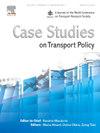Adolescents’ travel patterns to various destinations and independent mobility across settlement types
IF 3.3
Q3 TRANSPORTATION
引用次数: 0
Abstract
Active travel could contribute to increased physical activity among children and adolescents. Additionally, when the adolescents independently travel to various destinations, they usually present physically active profiles. However, the characteristics of the home neighbourhood are related to the active travel patterns and independent mobility of adolescents and may differ across settlement types. Therefore, this study compared adolescents’ mode of travel and who they travelled with, to various destinations (excluding school) as well as how far adolescents were allowed to travel on foot or by bicycle without adult supervision across various settlement types. Participants were 838 adolescents living in different settlement types (i.e. medium-to-large urban areas (n = 177), small urban areas (n = 506) and rural areas (n = 155)) in the Otago region of New Zealand. Adolescents self-reported their sociodemographic characteristics, mode of travel and independent mobility in a supervised online questionnaire. Differences between the three settlement types were compared using the Chi-squared test. The car was the most frequently used mode of travel by adolescents to friend’s home, relative’s home, shops/markets/restaurants and sport venues across all three settlement types. Cycling to all destinations was more common in small urban areas and rural areas, compared to medium-to-large urban areas (p < 0.05). The independent mobility was higher in small urban areas than other settlement types. Adolescents living in rural areas were allowed to travel independently further on foot or bicycle than their counterparts from urban areas (p < 0.05). Future interventions should encourage active travel and independent mobility taking into account specific characteristics of settlements where adolescents live.
青少年不同目的地的出行模式和跨聚落类型的独立流动
积极的旅行有助于增加儿童和青少年的身体活动。此外,当青少年独立旅行到不同的目的地时,他们通常表现出身体活跃的特征。然而,家庭社区的特征与青少年的主动旅行模式和独立流动有关,并且可能因住区类型而异。因此,本研究比较了青少年的旅行方式和他们与谁一起旅行,到不同的目的地(不包括学校),以及在不同的定居类型中,青少年在没有成人监督的情况下可以步行或骑自行车旅行的距离。参与者是生活在新西兰奥塔哥地区不同定居类型(即中大型城市地区(n = 177),小城市地区(n = 506)和农村地区(n = 155))的838名青少年。青少年在一份有监督的在线问卷中自我报告了他们的社会人口特征、旅行方式和独立流动性。采用卡方检验比较三种沉降类型之间的差异。汽车是青少年去朋友家、亲戚家、商店/市场/餐馆和体育场馆最常用的出行方式。与中大型城市地区相比,骑车前往所有目的地在小城市地区和农村地区更为普遍(p <;0.05)。小城市地区的独立流动性高于其他聚落类型。与城市地区的青少年相比,生活在农村地区的青少年被允许步行或骑自行车独立旅行更远(p <;0.05)。今后的干预措施应鼓励积极旅行和独立流动,同时考虑到青少年居住的住区的具体特点。
本文章由计算机程序翻译,如有差异,请以英文原文为准。
求助全文
约1分钟内获得全文
求助全文

 求助内容:
求助内容: 应助结果提醒方式:
应助结果提醒方式:


